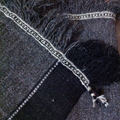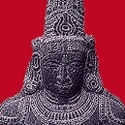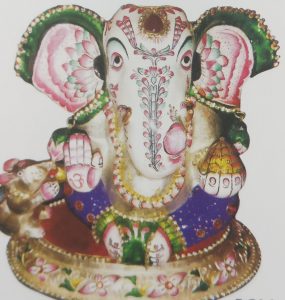Gond tribal paintings are traditional art of the Gond tribes residing over the entire Madhya Pradesh region. They celebrate the agricultural festivities, nature and symbiotic relation of flora and fauna. GEOGRAPHY: Madhya Pradesh located in the central India is marked by most ancient site of Bhimbetka, and has witnessed much cultural diversity. Madhya Pradesh can be distinguished in three cultural zones; Bundhelkhand- the land of palaces, forts and home to Bundela Rajputs; Malwa is situated along the banks of river Narmada in Madhya Pradesh with many religious ghats and pilgrimages associated with its history and Mandla tribal region is in the eastern Madhya Pradesh. The tribal belts of Gondwana, Nimar, Bhagor, Tarwangarh and Baghelkhand of Mandla practically dominate the entire region of Madhya Pradesh. Gond tribe is the largest tribe of Asia that contributes to the material culture of the region in significant ways. SIGNIFICANCE: Gond painting of tribal people of Mandla is one of the cultural manifestations. It is an admiration for nature, forests and the agriculture. The paintings are based on local festivals like Karwa chauth, Nag Panchmi, and Sanjhi when women paint their houses with homemade natural colours. The paintings are votive in nature and depict symbolism amongst snakes, birds and other animals. The paintings also celebrate the birth of Lord Krishna and traditionally it was done on walls. Later some of the artists shifted to painting on paper for commercial purposes. Gond painting has now found worldwide exposure and acclaim. Artists use their own imagination to interpret the nature and thus bring out characteristically different designs. STYLES: Every region of Madhya Pradesh has a distinct style of painting. Chiteras of Bundelkhand and women of Rajwar community are professional in lipai. Those from Pando and Satnami communities make linear designs on mud plaster base with fingers. The Malwa and Nimar region are known for the mandana floor decorations in geometrical shapes of peacocks, lions, swastika.
Gopalpur village is famous for its production of tussar fabrics. It is located in the Jajpur district of Odisha. The fabric is used for making dhotis, jodas, shawls, stoles, scarves and sarees. Threads are dyed in different shades, such as maroon, red, plum and rust. The tussar, ketia and gheecha fabrics are then enhanced with a weft designing method based on the cut shuttle or tapestry technique.
The production of gota ribbons is carried out in Nyla village, Khandela village, Jaipur city and Jauhari bazaar of Jaipur district. They are used as edging or or cut and folded into different types of motifs to be stitched onto a base fabric to create multitude of design and patterns. Items such as seekhiya gota or simple tape, lappa gota or twill-woven tape, siru gota or striped with colored motifs, sal gota or striated tape, thappa gota or heat set tape and gokhru or hand-crimped tape are executed under this craft-from. Tools such as loom, needle, thread, scissors, ari or hook and wooden frame are required for the crafting process.
Granite is easily available in Tamil Nadu and a large number of temples are carved of this stone. Pallava stone carvings which show a high degree of skill and craftsmanship evolved in the 6th century and the rock-cut caves of Mamallapuram, stone rathas/chariots and the stone shore temples are part of this expression. Great stone temples and carvings also date from the Chola period: examples of these are the Brihadeshwara temple at Thanjavur with its numerous carvings, the temple at Gangaikondacholapuram, the Airavathesvara temple at Darasuram and the Kampahareshvara temple at Thribhuvanam. Other examples include the Chidambaram temple with its 108 karanas of the Natya Shaastra/the canon of dance. the Ekambareshwara and Varadaraaja temples of Kanchipuram, the Meenakshi temple at Madurai, with its numerous sculptures, magnificent proportions, thousand-pillared mandapas, pillars of stone, towering gopurams/towers, larger than life sized reliefs and the long corridor of the Rameshwaram temple. Granite images have been essential for the construction of the fixed consecrated icons. The artisans around Mamallapuram chisel great blocks of granite to produce massive pillars as well as small icons. Stone carving is also practised in other parts of Tamil Nadu like Thirunelveli, Ramnad, Madurai and North Arcot districts. The sculptors belong to the Vishwakarma or Kammaalar community. The Shilpa Shaastras or the treatise on crafts detail the measurements and techniques of sculpting, the quality of stone, its maturity, texture, colour and so on. The stone used by the sculptor is hard so that it does not lose its shape easily or chip unexpectedly. The stone should have no flaws or kalanga (stain), rekha(patch) or bindu(spot). The tools used by the sculptors are made of mild steel in various sizes. To prevent the stone from cracking from the vibration of the instrument, the image is always carved with the stone laid flat on the ground whether the posture is seated or standing. After the figure has been carved, a ceremony called nayanonmilan is conducted and the figure gets sight, life and breath and becomes a living force. Then it is ceremoniously placed in the garbagriha or sanctum sanctorum.
Granite is easily available in Tamil Nadu and a large number of temples are carved of this stone. Pallava stone carvings which show a high degree of skill and craftsmanship evolved in the 6th century and the rock-cut caves of Mamallapuram, stone rathas/chariots and the stone shore temples are part of this expression. Great stone temples and carvings also date from the Chola period: examples of these are the Brihadeshwara temple at Thanjavur with its numerous carvings, the temple at Gangaikondacholapuram, the Airavathesvara temple at Darasuram and the Kampahareshvara temple at Thribhuvanam. Other examples include the Chidambaram temple with its 108 karanas of the Natya Shaastra/the canon of dance. the Ekambareshwara and Varadaraaja temples of Kanchipuram, the Meenakshi temple at Madurai, with its numerous sculptures, magnificent proportions, thousand-pillared mandapas, pillars of stone, towering gopurams/towers, larger than life sized reliefs and the long corridor of the Rameshwaram temple. Granite images have been essential for the construction of the fixed consecrated icons. The artisans around Mamallapuram chisel great blocks of granite to produce massive pillars as well as small icons. Stone carving is also practised in other parts of Tamil Nadu like Thirunelveli, Ramnad, Madurai and North Arcot districts. The sculptors belong to the Vishwakarma or Kammaalar community. The Shilpa Shaastras or the treatise on crafts detail the measurements and techniques of sculpting, the quality of stone, its maturity, texture, colour and so on. The stone used by the sculptor is hard so that it does not lose its shape easily or chip unexpectedly. The stone should have no flaws or kalanga (stain), rekha(patch) or bindu(spot). The tools used by the sculptors are made of mild steel in various sizes. To prevent the stone from cracking from the vibration of the instrument, the image is always carved with the stone laid flat on the ground whether the posture is seated or standing. After the figure has been carved, a ceremony called nayanonmilan is conducted and the figure gets sight, life and breath and becomes a living force. Then it is ceremoniously placed in the garbagriha or sanctum sanctorum.
The traditional footwear of the Paharis of Himachal is the pula chappal made of the sacred grass of shale -cannabis/ bhang. Considered appropriate footwear even for religious occasions these pula chappals are worn within temple precincts. While extremely light-weight they are also strong and warm enough to be used while walking on snow. The technique used is to process and dry strips of cannabis grass or buckwheat stem and shape it into long rope like strips that strengthened by strenuous twisting and stretching. A basic system of hand-measures is used to make different sizes. Loops are fashioned in relation to toe shapes from the rope. The body of the chappal is constructed by inter-twining fine threads of grass that has been spun on a takli, spindle. The upper surface is embroidered in bright contrasting colours of wool in a blanket stitch. The coloured stripes and geometric patterns used to enhance the natural shade of the grass resemble the border decorations of the Kullu shawl and caps.
Meenakari, also called enamelling, is the art of decorating a metal surface by fusing mineral substances on it. Meenakari was introduced into India by the Mughals. The process is often applied to kundan—articles of jewellery studded with gemstones set with a layer of gold foil between the stone and the mount on one side, while the reverse is lavishly enamelled using the meena technique. The lustre of the meena, the enamelled reverse side, increases over time due to contact with the wearer's body and clothes. The brilliance of the diamonds and other stones is effectively complemented by the multihued enamel of the meena. Varanasi, in Uttar Pradesh, is one of the oldest cities in India and has a very rich culture and history.Itwas the capital of the ancient Kashi region.
The present meenakar in Varanasi claimed that the postion of the art of meenakari was prosperous till about hundred years ago.







